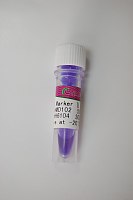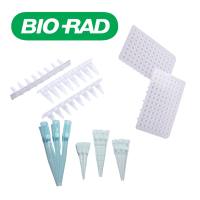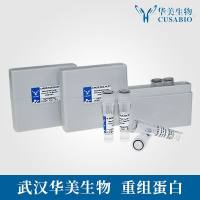Release of DNA Oligonucleotides and Their Conjugates from Controlled‐Pore Glass Under Thermolytic Conditions
互联网
- Abstract
- Table of Contents
- Materials
- Figures
- Literature Cited
Abstract
The sequential functionalization of long?chain alkylamine controlled?pore glass (CPG) with a 3?hydroxypropyl?(2?cyanoethyl)thiophosphoryl linker and a dinucleoside phosphorotetrazolide leads to a uniquely engineered support for solid?phase synthesis. Unlike conventional succinylated?CPG supports, this support is designed to allow oligonucleotide deprotection and elimination of deprotection side?products to proceed without release of the oligonucleotide. When needed, the DNA oligonucleotide can be thermolytically released in 2 hr under essentially neutral conditions. The modified CPG support has been successfully employed in the synthesis of both native and fully phosphorothioated DNA 20?mers. On the basis of reversed?phase HPLC and electrophoretic analyses, the purity of the released oligonucleotides is comparable to that of identical oligonucleotides synthesized from succinylated?CPG supports, in terms of both shorter?than?full?length oligonucleotide contaminants and overall yields. The detailed preparation of DNA oligonucleotides conjugated with exemplary reporter or functional groups, either at the 3??terminus or at both 3?? and 5??termini, is also described. Curr. Protoc. Nucleic Acid Chem. 35:3.17.1?3.17.21. © 2008 by John Wiley & Sons, Inc.
Keywords: deoxyribonucleoside phosphorodiamidites; solid?phase synthesis; modified CPG support; thermolytic conditions; DNA oligonucleotides conjugates
Table of Contents
- Introduction
- Basic Protocol 1: Functionalization of CPG with Covalently Linked Dinucleotides and Its Application to Solid‐Phase Synthesis of Native and Modified DNA Oligonucleotides
- Support Protocol 1: Preparation of Deoxyribonucleoside Phosphorodiamidites
- Basic Protocol 2: Application of the Dinucleotide‐Bound Support for Synthesis of a DNA Oligonucleotide with 5′‐ and 3′‐Functional Groups
- Alternate Protocol 1: Application of the Hydroxylated CPG Support for Synthesis of a DNA Oligonucleotide with a 3′‐Reporter Group
- Commentary
- Literature Cited
- Figures
Materials
Basic Protocol 1: Functionalization of CPG with Covalently Linked Dinucleotides and Its Application to Solid‐Phase Synthesis of Native and Modified DNA Oligonucleotides
Materials
Support Protocol 1: Preparation of Deoxyribonucleoside Phosphorodiamidites
Materials
Basic Protocol 2: Application of the Dinucleotide‐Bound Support for Synthesis of a DNA Oligonucleotide with 5′‐ and 3′‐Functional Groups
Materials
Alternate Protocol 1: Application of the Hydroxylated CPG Support for Synthesis of a DNA Oligonucleotide with a 3′‐Reporter Group
|
Figures
-

Figure 3.17.1 Preparation of CPG support S.3 . Cap A, acetic anhydride/pyridine/THF; Cap B, 10% 1‐methylimidazole in THF; CPG, 500 Å long‐chain alkylamine controlled‐pore glass; DMTr, 4,4′‐dimethoxytrityl; ETT, 5‐ethylthio‐1 H ‐tetrazole. Adapted and reprinted with permission from Grajkowski et al. (). Copyright 2008 American Chemical Society. View Image -

Figure 3.17.2 Preparation of the CPG‐linked dinucleotide S.7 . Note that the capping reaction should be performed before oxidation, but after sulfurization. BP , thymin‐1‐yl, N 4 ‐benzoylcytosin‐1‐yl, N 6 ‐benzoyladenin‐9‐yl, or N 2 ‐isobutyrylguanin‐9‐yl; Cap A, acetic anhydride/pyridine/THF; Cap B, 10% 1‐methylimidazole in THF; CPG, 500 Å long‐chain alkylamine controlled‐pore glass; DMTr, 4,4′‐dimethoxytrityl; Lev, levulinyl. Adapted and reprinted with permission from Grajkowski et al. (). Copyright 2008 American Chemical Society. View Image -

Figure 3.17.3 Gas‐phase deprotection and thermolytic release of dinucleoside or oligonucleoside phosphate/thiophosphate diesters from the CPG support. B, thymin‐1‐yl, cytosin‐1‐yl, adenin‐9‐yl, or guanin‐9‐yl; Cap A, acetic anhydride/pyridine/THF; Cap B, 10% 1‐methylimidazole in THF; CPG, 500 Å long‐chain alkylamine controlled‐pore glass; PBS, phosphate‐buffered saline; TCA, trichloroacetic acid. Adapted and reprinted with permission from Grajkowski et al. (). Copyright 2008 American Chemical Society. View Image -

Figure 3.17.4 RP‐HPLC analysis of unpurified 5′‐d(CGACTGTGAATCGATGCCAT) and 5′‐d(CPS GPS APS CPS TPS GPS TPS GPS APS APS TPS CPS GPS APS TPS GPS CPS CPS APS T). (A,B ) Native 20‐mer synthesized on commercial CPG (A ) or CPG support S.7 (B ) under standard conditions. (C,D ) Fully phosphorothioated 20‐mer synthesized on commercial CPG (C ) or CPG support S.7 (D ) under standard conditions. Synthesis, nucleobase and phosphate deprotection, thermolytic cleavage from the support, and RP‐HPLC analyses were performed as described in . Peak heights are all normalized to the highest peak, which is set to 1 arbitrary unit. Adapted and reprinted with permission from Grajkowski et al. (). Copyright 2008 American Chemical Society. View Image -

Figure 3.17.5 Polyacrylamide gel electrophoresis of unpurified 5′‐d(CGACTGTG‐AATCGATGCCAT) and 5′‐d(CPS GPS APS CPS TPS GPS TPS GPS APS APS TPS CPS GPS APS TPS GPS CPS CPS ‐APS T) under denaturing conditions. (A ) Native 20‐mer synthesized on unmodified CPG (left lane) and CPG support S.7 (right lane). (B ) Fully phosphorothioated 20‐mer synthesized on unmodified CPG (left lane) and CPG support S.7 (right lane). Synthesis, nucleobase and phosphate deprotection, thermolytic cleavage from the support, and RP‐HPLC analyses were all performed as described in . Adapted and reprinted with permission from Grajkowski et al. (). Copyright 2008 American Chemical Society. View Image -

Figure 3.17.6 Preparation of deoxyribonucleoside phosphorodiamidite S.4 . BP , thymin‐1‐yl, N 4 ‐benzoylcytosin‐1‐yl, N 6 ‐benzoyladenin‐9‐yl, or N 2 ‐isobutyrylguanin‐9‐yl; DMTr, 4,4′‐dimethoxytrityl. View Image -

Figure 3.17.7 Preparation of a DNA oligonucleotide conjugated with 5′‐ and 3′‐functional groups. Cap A, acetic anhydride/pyridine/THF; Cap B, 10% 1‐methylimidazole in THF; CPG, 500 Å long‐chain alkylamine controlled‐pore glass; DMTr, 4,4′‐dimethoxytrityl; MMTr, 4‐monomethoxytrityl; PBS, phosphate‐buffered saline; TCA, trichloroacetic acid; Bz, benzoyl; iBu, Isobutyryl; p, 2‐cyanoethyl phosphoryl. Adapted and reprinted with permission from Grajkowski et al. (). Copyright 2008 American Chemical Society. View Image -

Figure 3.17.8 Preparation of a DNA oligonucleotide conjugated with a 3′‐reporter group (R). Cap A, acetic anhydride/pyridine/THF; Cap B, 10% 1‐methylimidazole in THF; CPG, 500 Å long‐chain alkylamine controlled‐pore glass; DMTr, 4,4′‐dimethoxytrityl; PBS, phosphate‐buffered saline; R, 1‐pyrenebutyl; TCA, trichloroacetic acid; p, 2‐cyanoethyl phosphoryl. Adapted and reprinted with permission from Grajkowski et al. (). Copyright 2008 American Chemical Society. View Image -

Figure 3.17.9 RP‐HPLC analysis of unpurified 3′‐pyrenylated DNA oligonucleotide S .18 . Nucleobase and phosphate deprotection, thermolytic cleavage, and RP‐HPLC were performed as described in . (A ) Chromatogram of S.18 recorded at 260 nm. (B ) Chromatogram of S.18 recorded at 340 nm. Adapted and reprinted with permission from Grajkowski et al. (). Copyright 2008 American Chemical Society. View Image -

Figure 3.17.10 Thermolytic cyclodeesterification of thymidylyl‐(3′ → 5′)‐thymidine thiophosphate 3‐thiophosphato‐1‐propyl ester or its 4‐thiophosphato‐1‐butyl ester. Adapted and reprinted with permission from Grajkowski et al. (). Copyright 2007 American Chemical Society. View Image -

Figure 3.17.11 RP‐HPLC chromatograms of exemplary dinucleoside phosphate diesters (A ) and dinucleoside phosphorothioate diesters (B ) thermolytically released from modified CPG support S.8 (Fig. ). Adapted and reprinted with permission from Grajkowski et al. (). Copyright 2008 American Chemical Society. View Image
Videos
Literature Cited
| Literature Cited | |
| Beaucage, S.L. 1999. Attachment of reporter and conjugate groups to DNA. In Comprehensive Natural Products Chemistry, Volume 7: DNA and Aspects of Molecular Biology (D. Barton, K. Nakanishi, O. Meth‐Cohn, and E.T. Kool, eds.) pp. 153‐249. Elsevier Science Publishing, New York. | |
| Beaucage, S.L. and Iyer, R.P. 1992. Advances in the synthesis of oligonucleotides by the phosphoramidite approach. Tetrahedron 48:2223‐2311. | |
| Berner, S., Mühlegger, K., and Seliger, H. 1989. Studies on the role of tetrazole in the activation of phosphoramidites. Nucleic Acids Res. 17:853‐864. | |
| Boal, J.H., Wilk, A., Harindranath, N., Max, E.E., Kempe, T., and Beaucage, S.L. 1996. Cleavage of oligodeoxyribonucleotides from controlled‐pore glass supports and their rapid deprotection by gaseous amines. Nucleic Acids Res. 24:3115‐3117. | |
| Cieślak, J. and Beaucage, S.L. 2003. Thermolytic properties of 3‐(2‐pyridyl)‐1‐propyl and 2‐[N‐methyl‐N‐(2‐pyridyl)]aminoethyl phosphate/thiophosphate protecting groups in solid‐phase synthesis of oligodeoxyribonucleotides. J. Org. Chem. 68:10123‐10129. | |
| Cieślak, J., Grajkowski, A., Livengood, V., and Beaucage, S.L. 2004. The thermolytic 4‐methylthio‐1‐butyl group for phosphate/thiophosphate protection in solid‐phase synthesis of DNA oligonucleotides. J. Org. Chem. 69:2509‐2515. | |
| Dyke, J.M., Groves, A.P., Morris, A., Ogden, J.S., Dias, A.A., Oliveira, A.M.S., Costa, M.L., Barros, M.T., Cabral, M.H., and Moutinho, A.M.C. 1997. Study of the thermal decomposition of 2‐azidoacetic acid by photoelectron and matrix isolation infrared spectroscopy. J. Am. Chem. Soc. 119:6883‐6887. | |
| Grajkowski, A., Wilk, A., Chmielewski, M.K., Phillips, L.R., and Beaucage, S.L. 2001. The 2‐(N‐formyl‐N‐methyl)aminoethyl group as a potential phosphate/thiophosphate protecting group in solid‐phase oligodeoxyribonucleotide synthesis. Org. Lett. 3:1287‐1290. | |
| Grajkowski, A., Ausín, C., Kauffman, J.S., Snyder, J., Hess, S., Lloyd, J.R., and Beaucage, S.L. 2007. Solid‐phase synthesis of thermolytic DNA oligonucleotides functionalized with a single 4‐hydroxy‐1‐butyl or 4‐phosphato/‐thiophosphato‐1‐butyl thiophosphate protecting group. J. Org. Chem. 72:805‐815. | |
| Grajkowski, A., Cieślak, J., Kauffman, J.S., Duff, R.J., Norris, S., Freedberg, D., and Beaucage, S.L. 2008. Thermolytic release of covalently linked DNA oligonucleotides and their conjugates from controlled‐pore glass at near neutral pH. Bioconjugate Chem. 19:1696‐1706. | |
| Hassner, A., Strand, G., Rubinstein, M., and Patchornik, A. 1975. Levulinic esters. Alcohol protecting group applicable to some nucleosides. J. Am. Chem. Soc. 97:1614‐1615. | |
| Iyer, R.P., Phillips, L.R., Egan, W., Regan, J.B., and Beaucage, S.L. 1990. The automated synthesis of sulfur‐containing oligodeoxyribonucleotides using 3H‐1,2‐benzodithiol‐3‐one 1,1‐dioxide as a sulfur‐transfer reagent. J. Org. Chem. 55:4693‐4699. | |
| Kumar, R., El‐Sagheer, A., Tumpane, J., Lincoln, P., Wilhelmsson, L.M., and Brown, T. 2007. Template‐directed oligonucleotide strand ligation, covalent intramolecular DNA circularization and catenation using click chemistry. J. Am. Chem. Soc. 129:6859‐6864. | |
| Letsinger, R.L. and Mahadevan, V. 1965. Oligonucleotide synthesis on a polymer support. J. Am. Chem. Soc. 87:3526‐3527. | |
| Letsinger, R.L. and Mahadevan, V. 1966. Stepwise synthesis of oligodeoxyribonucleotides on an insoluble polymer support. J. Am. Chem. Soc. 88:5319‐5324. | |
| Marugg, J.E., Burik, A., Tromp, M., van der Marel, G.A., and van Boom, J.H. 1986. A new and versatile approach to the preparation of valuable deoxynucleoside 3′‐phosphite intermediates. Tetrahedron Lett. 27:2271‐2274. | |
| Merrifield, R.B. 1963. Solid phase peptide synthesis. I. The synthesis of a tetrapeptide. J. Am. Chem. Soc. 85:2149‐2154. | |
| Merrifield, R.B. 1965. Automated synthesis of peptides. Science 150:178‐185. | |
| Regan, J.B., Phillips, L.R., and Beaucage, S.L. 1992. Large‐scale preparation of the sulfur‐transfer reagent 3H‐1,2‐benzodithiol‐3‐one 1,1‐dioxide. Org. Prep. Proc. Int. 24:488‐492. | |
| Seeberger, P.H. and Haase, W.‐C. 2000. Solid‐phase oligosaccharide synthesis and combinatorial carbohydrate libraries. Chem. Rev. 100:4349‐4393. | |
| Seeberger, P.H. and Werz, D.B. 2005. Automated synthesis of oligosaccharides as a basis for drug discovery. Nature Rev. Drug Discov. 4:751‐763. | |
| Virta, P., Katajisto, J., Niittymäki, T., and Lönnberg, H. 2003. Solid‐supported synthesis of oligomeric bioconjugates. Tetrahedron 59:5137‐5174. | |
| Wilk, A., Grajkowski, A., Phillips, L.R., and Beaucage, S.L. 2000. Deoxyribonucleoside cyclic N‐acylphosphoramidites as a new class of monomers for the stereocontrolled synthesis of oligothymidylyl‐ and oligocytidylyl‐phosphorothioates. J. Am. Chem. Soc. 122:2149‐2156. | |
| Wilk, A., Chmielewski, M.K., Grajkowski, A., Phillips, L.R., and Beaucage, S.L. 2001. The 4‐oxopentyl group, as a labile phosphate/thiophosphate protecting group for synthetic oligodeoxyribonucleotides. Tetrahedron Lett. 42:5635‐5639. | |
| Wilk, A., Chmielewski, M.K., Grajkowski, A., Phillips, L.R., and Beaucage, S.L. 2002. The 3‐[(N‐tert‐butyl)carboxamido]‐1‐propyl group as an attractive phosphate/thiophosphate protecting group for solid‐phase oligodeoxyribonucleotide synthesis. J. Org. Chem. 67:6430‐6438. |








